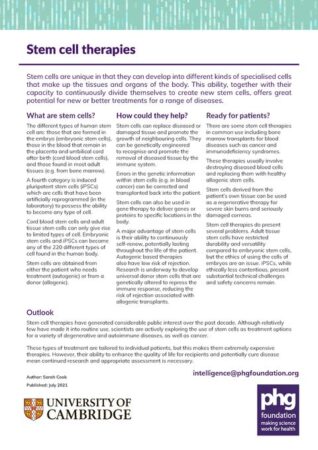Stem cells are unique in that they can develop into different kinds of specialised cells that make up the tissues and organs of the body. This ability, together with their capacity to continuously divide themselves to create new stem cells, offers great potential for new or better treatments for a range of diseases.
What are stem cells?
The different types of human stem cell are: those that are formed in the embryo (embryonic stem cells), those in the blood that remain in the placenta and umbilical cord after birth (cord blood stem cells), and those found in most adult tissues (e.g. from bone marrow).
A fourth category is induced pluripotent stem cells (iPSCs) which are cells that have been artificially reprogrammed (in the laboratory) to possess the ability to become any type of cell.
Cord blood stem cells and adult tissue stem cells can only give rise to limited types of cell. Embryonic stem cells and iPSCs can become any of the 220 different types of cell found in the human body.
Stem cells are obtained from either the patient who needs treatment (autogenic) or from a donor (allogenic).
How could they help?
Stem cells can replace diseased or damaged tissue and promote the growth of neighbouring cells. They can be genetically engineered to recognise and promote the removal of diseased tissue by the immune system.
Errors in the genetic information within stem cells (e.g. in blood cancer) can be corrected and transplanted back into the patient.
Stem cells can also be used in gene therapy to deliver genes or proteins to specific locations in the body.
A major advantage of stem cells is their ability to continuously self-renew, potentially lasting throughout the life of the patient. Autogenic based therapies also have low risk of rejection. Research is underway to develop universal donor stem cells that are genetically altered to repress the immune response, reducing the risk of rejection associated with allogenic transplants.
Ready for patients?
There are some stem cell therapies in common use including bone marrow transplants for blood diseases such as cancer and immunodeficiency syndromes.
These therapies usually involve destroying diseased blood cells and replacing them with healthy allogenic stem cells.
Stem cells derived from the patient’s own tissue can be used as a regenerative therapy for severe skin burns and seriously damaged corneas.
Stem cell therapies do present several problems. Adult tissue stem cells have restricted durability and versatility compared to embryonic stem cells, but the ethics of using the cells of embryos are an issue. iPSCs, while ethically less contentious, present substantial technical challenges and safety concerns remain.
Outlook
Stem cell therapies have generated considerable public interest over the past decade. Although relatively few have made it into routine use, scientists are actively exploring the use of stem cells as treatment options for a variety of degenerative and autoimmune diseases, as well as cancer.
These types of treatment are tailored to individual patients, but this makes them extremely expensive therapies. However, their ability to enhance the quality of life for recipients and potentially cure disease mean continued research and appropriate assessment is necessary.

